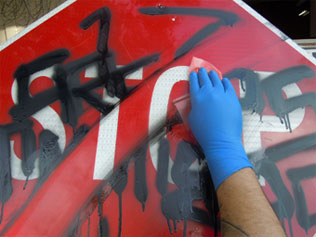 The chemical removal method of graffiti removal is perhaps the most common form of graffiti removal. Before you commence this method of graffiti removal, it is important to have an understanding of 2 important factors.
The chemical removal method of graffiti removal is perhaps the most common form of graffiti removal. Before you commence this method of graffiti removal, it is important to have an understanding of 2 important factors.
Firstly you will need to identify the type of graffiti. For example what is the graffiti made of, spray paint, marker, crayon, pencil etc. Certain paint or graffiti stripping chemicals will work better on the different graffiti material types. Next you need to identify the substrate that the graffiti is present on.
Bricks, blocks, natural stone and other masonry can tolerate just about any type of graffiti removal product. Masonry is also highly porous and therefore a shadow remover is often required in conjunction with the graffiti remover chemical to remove all traces of the graffiti, including the traces of paint or graffiti deep within the pores of the substrate.
Painted surfaces, metal, glass, plastic and other non-porous building materials or substrates can be less tolerate and can be much more easily damaged with the wrong graffiti removal chemical. This is when you will need to research and ensure that the chemical that you choose to undertake the removal task is compatible with the substrate you are removing the graffiti from. Using the wrong chemical on these surfaces can cause damage which can be permanent.
Chemical graffiti removers can vary substantially in strength. The stronger the remover, the faster it will break down the bond of the graffiti and the substrate. Mineral turpentine or mentholated spirits can be effective to remove some graffiti from some non-porous substrates such as metal or glass. If these mild solvents do not work, then they are a number of proprietor graffiti removal solvents on the market that will be suitable to complete the task.
When handling graffiti removal chemicals and products, safety is an important factor to consider at all times. Make sure to wear gloves and it is also recommended that you wear a respirator especially when working in a confined space or a poorly ventilated area. Always opt for an environmentally friendly stripping agent to minimize the detrimental impact on our environment.
For more information on the impact that some of the leading graffiti removal products and information on their ingredients and effectiveness click here

